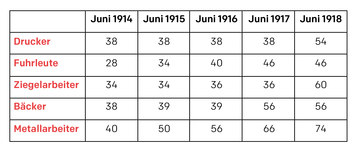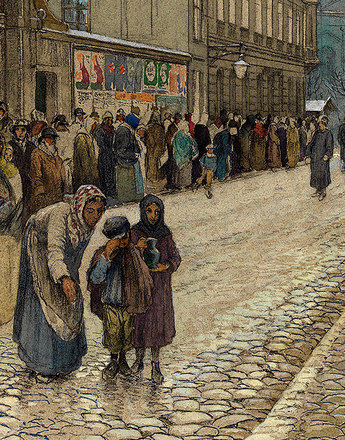The losers under inflation: huge falls in employee real wages
Blue- and white-collar workers suffered particularly under devaluation. The de facto disappearance of trade union lobbying as a result of the policy of ‘internal peace’ led, as with civil servants, to huge falls in real wages. It was only in 1917 that the condition of wage earners began to improve again.
In 1913, the wage ratio in the national economy amounted to 51%. No figures are available for the war period, but it was probably considerably less. It was only after the war that it rose again, and by 1924, the first year for which calculations are available, reached 57%. The decline resulting from the war was a consequence of the policy of ‘internal peace’, according to which the independent trade unions and the Social Democrat Party supported the state's war policy. The workers’ lobbies waived wage increases and strikes at the beginning of the war. This only changed in 1916/1917, when there were spontaneous strike movements that were triggered above all by the poor food situation and led to a certain adjustment of wages. Particularly in businesses that were of significance for the war, there were in part considerable increases in nominal wages, with bonuses also being granted to compensate for price rises. Overall, the losses in terms of real wages during the war were huge in the light of a 16-fold increase in prices. According to calculations by a contemporary expert, taking 1913/14 as the starting point, the real wage index fell by 1916/17 to a value of 64 and then to 37 in the 1917/18 period.
Hence it is no exaggeration to say that the workers involuntarily ‘contributed’ to financing the war. As a sort of compensation for the considerable fall in wages, the trade unions attempted to achieve a redistribution within the workforce by increasing the income of the low earners more strongly at the expense of the more highly qualified. The result was a levelling of earnings within the workforce. The aim of this policy was to reduce tension between the various worker categories.
At the same time, from autumn 1916, the state took measures to improve the social situation of wage earners. At the end of 1916, the Office for General Nourishment was set up. In addition, an Imperial Regulation of 18 March 1917 created an appeal commission that dealt with wage questions and the elimination of excesses within militarised work. Tenancy protection was introduced for certain categories of housing, etc. Despite all the state interventions, hunger, illness and other symptoms of deficiencies were a constant threat to the population. The disorganisation of daily life continued, and it is hardly surprising that social unrest increased.
Translation: David Wright
Hautmann, Hans (Hrsg.): „Wir sind keine Hunde“. Das Protokoll des Arbeitertages vom 5. November 1916 in Wien, Wien 2009
Winkler, Wilhelm: Die Einkommensverschiebungen in Österreich während des Weltkrieges, Wien 1930
-
Chapters
- Raising the costs of the war
- War-related inflation in Austria
- The mechanism of financing the war
- Extent, causes and effects of inflation 1914 to 1918
- The losers under inflation: huge falls in employee real wages
- Discharge of debts through inflation
- The financial consequences of the war for the new republic







